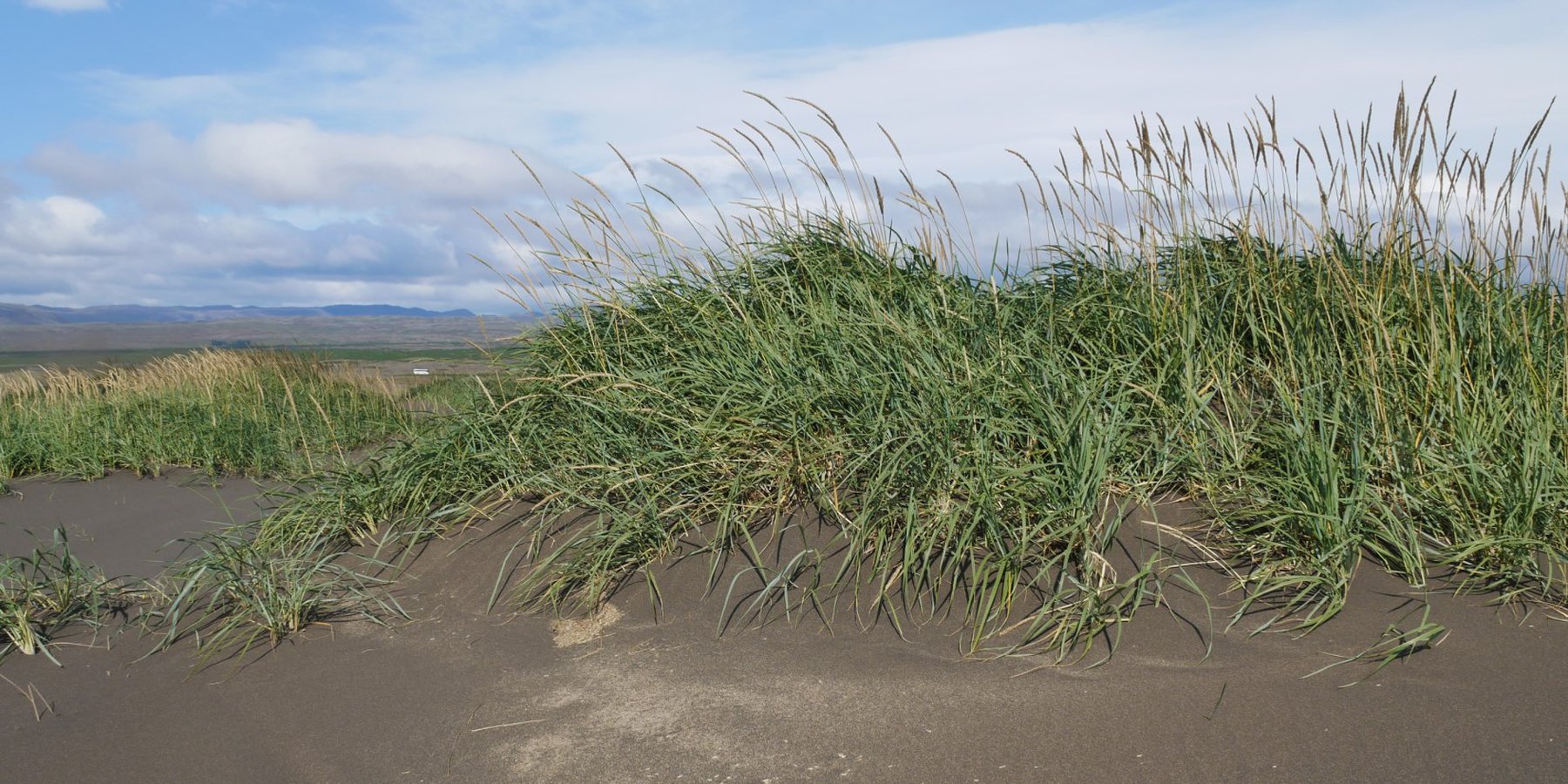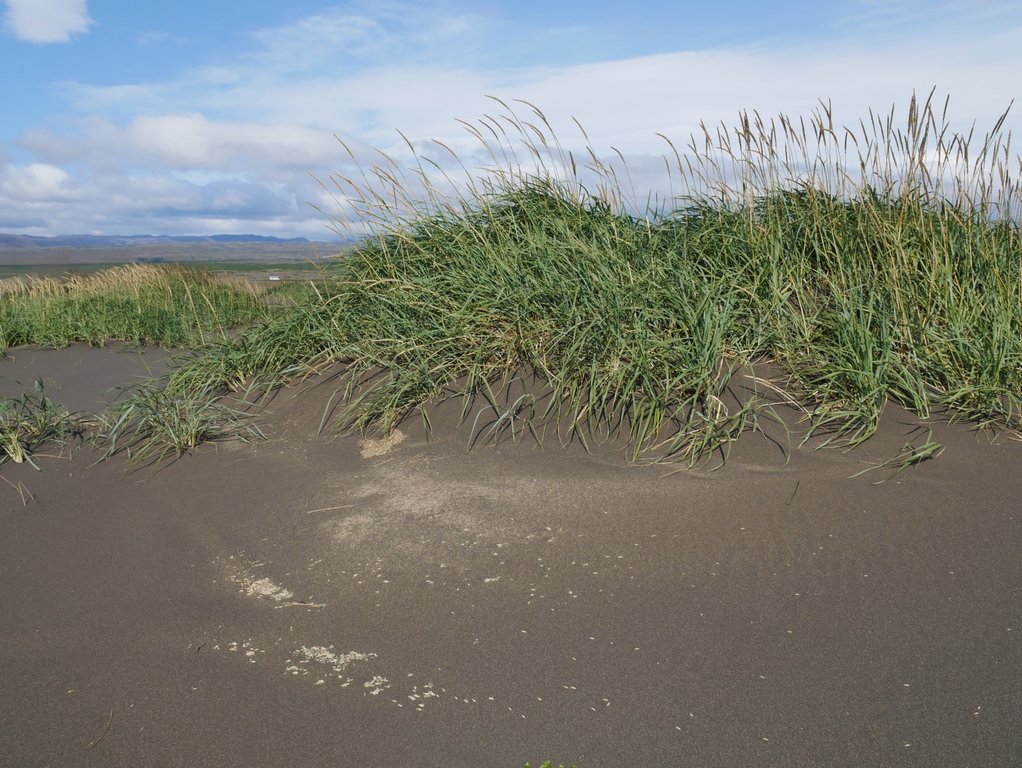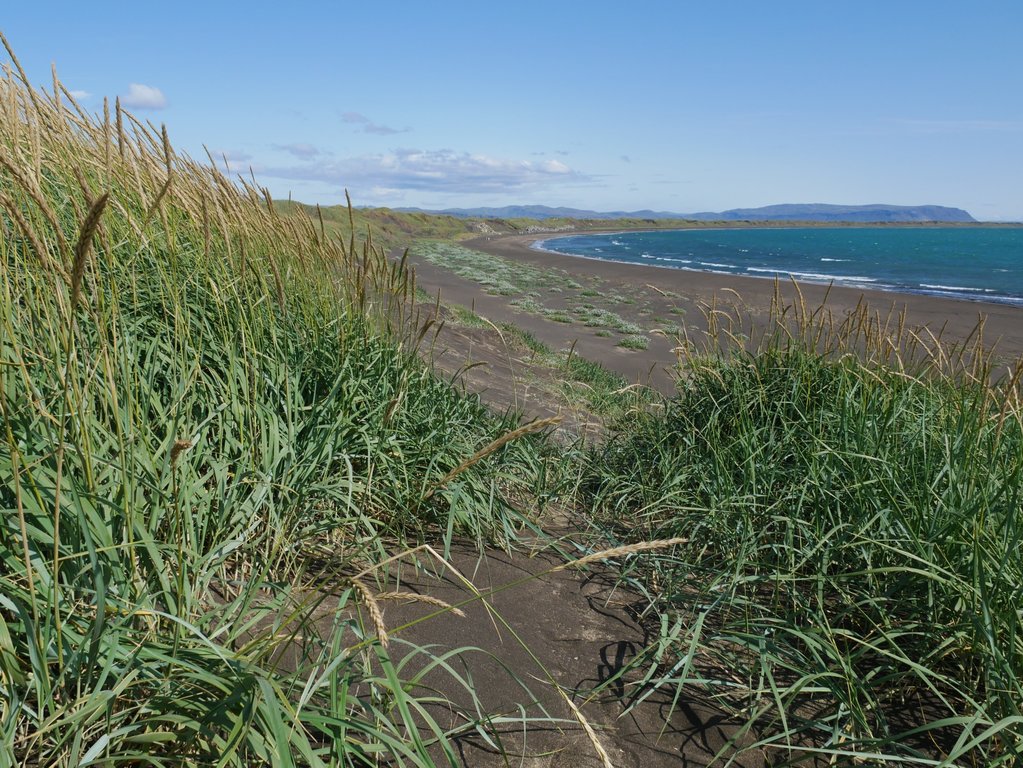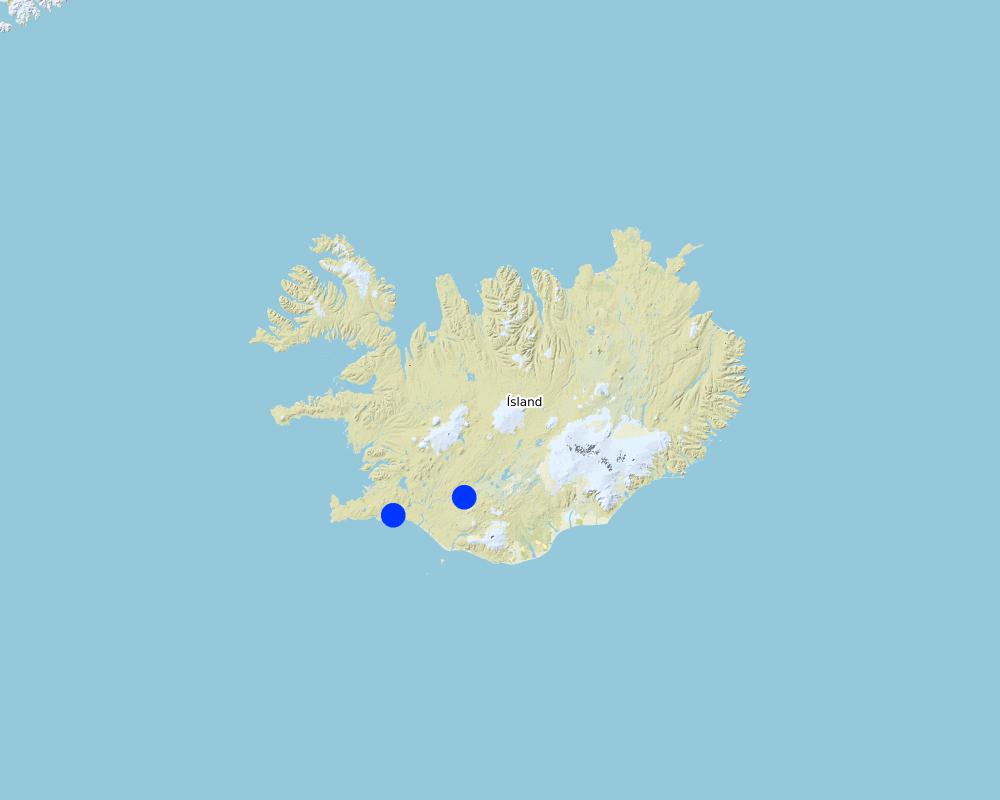Seeding lyme grass for land reclamation and to protect the soil against wind erosion [Iceland]
- Creation:
- Update:
- Compiler: Jan Reichert
- Editor: Hanspeter Liniger
- Reviewer: Hanspeter Liniger
technologies_5756 - Iceland
View sections
Expand all Collapse all1. General information
1.2 Contact details of resource persons and institutions involved in the assessment and documentation of the Technology
Key resource person(s)
SLM specialist:
Runólfsson Sveinn
Soil Conservation Service of Iceland
Iceland
1.3 Conditions regarding the use of data documented through WOCAT
The compiler and key resource person(s) accept the conditions regarding the use of data documented through WOCAT:
Yes
1.4 Declaration on sustainability of the described Technology
Is the Technology described here problematic with regard to land degradation, so that it cannot be declared a sustainable land management technology?
No
2. Description of the SLM Technology
2.1 Short description of the Technology
Definition of the Technology:
Lyme grass is is sown in by hand or by machines for revegetation in sandy areas to increase the vegetation cover, to capture and stabilise the moving sand. The extensive root system allows the plant to grow in sandy underground and thus protects the soil from extensive wind erosion.
2.2 Detailed description of the Technology
Description:
The lyme grass (Leymus arenarius) is a native pioneer plant in Iceland. Due to its extensive root system it survives in sand and even in sand blown. The sand can be captured and stabilised and vegetation cover increases. In this way new vegetation with other plants can further develop. Therefore, this plant is used on degraded land with sandy soils to restore and hinder it from further erosion. Wind erosion can be minimized or stopped. Lyme grass protects and prevents the soil from being blown away and causing damage on- and offsite. For these reasons, it was applied in various locations throughout Iceland. The plant spreads by itself and produces large amounts of seeds every year. The lyme grass is winter hardy and copes well with droughts because of its long roots and it is highly appreciated because it brings a strong long-term improvement onsite and provideds offsite benefits. Furthermore, the lyme grass can also store large quantities of carbon.
The plant was formerly planted by hand. Thanks to the development of new techniques and machinery it can nowadays be planted / sown on a large scale using tractors and suitable cultivation machines. In order to promote growth and spread, the plants are supported with fertilizer in the years after planting. Because the lyme grass is sensitive to grazing, a fence is often built to protect the area from livestock. In more advanced restored land, seasonally controlled grazing with sheep can take place again.
2.3 Photos of the Technology
2.5 Country/ region/ locations where the Technology has been applied and which are covered by this assessment
Country:
Iceland
Region/ State/ Province:
South of Iceland
Further specification of location:
Thorlákshöfn and Hekla area
Specify the spread of the Technology:
- evenly spread over an area
If precise area is not known, indicate approximate area covered:
- 10-100 km2
Is/are the technology site(s) located in a permanently protected area?
Yes
If yes, specify:
Fences protect the Lyme grass from grazing by sheep.
Comments:
Lyme grass is very sensitive to grazing.
Map
×2.6 Date of implementation
If precise year is not known, indicate approximate date:
- 10-50 years ago
2.7 Introduction of the Technology
Specify how the Technology was introduced:
- during experiments/ research
- through projects/ external interventions
3. Classification of the SLM Technology
3.1 Main purpose(s) of the Technology
- reduce, prevent, restore land degradation
- protect a watershed/ downstream areas – in combination with other Technologies
- preserve/ improve biodiversity
- reduce risk of disasters
3.2 Current land use type(s) where the Technology is applied
Land use mixed within the same land unit:
No

Grazing land
Extensive grazing:
- Ranching
Intensive grazing/ fodder production:
- Cut-and-carry/ zero grazing
Animal type:
- sheep
Is integrated crop-livestock management practiced?
No
Products and services:
- meat
- whool
3.3 Has land use changed due to the implementation of the Technology?
Has land use changed due to the implementation of the Technology?
- Yes (Please fill out the questions below with regard to the land use before implementation of the Technology)
Land use mixed within the same land unit:
No

Other
Specify:
Protected area
Remarks:
Because the lyme grass is very sensitive to grazing, grazing is excluded in a first step. After reclamation, the land can be used again for controlled grazing during the summer months. Sandy areas remain protected because of their vulnerability to wind erosion. For rehabilitation, lyme grass can be combined with birch tree planting.
3.4 Water supply
Water supply for the land on which the Technology is applied:
- rainfed
Comments:
There are large deposits of groundwater in the area around Thorlákshöfn.
3.5 SLM group to which the Technology belongs
- improved ground/ vegetation cover
- ecosystem-based disaster risk reduction
3.6 SLM measures comprising the Technology

vegetative measures
- V2: Grasses and perennial herbaceous plants
Comments:
Could be combined with birch tree planting.
3.7 Main types of land degradation addressed by the Technology

soil erosion by wind
- Et: loss of topsoil
- Ed: deflation and deposition
- Eo: offsite degradation effects
3.8 Prevention, reduction, or restoration of land degradation
Specify the goal of the Technology with regard to land degradation:
- reduce land degradation
- restore/ rehabilitate severely degraded land
4. Technical specifications, implementation activities, inputs, and costs
4.2 General information regarding the calculation of inputs and costs
Specify how costs and inputs were calculated:
- per Technology area
Indicate size and area unit:
Project costs in Thorlákshöfn
Specify currency used for cost calculations:
- USD
4.4 Costs and inputs needed for establishment
| Specify input | Unit | Quantity | Costs per Unit | Total costs per input | % of costs borne by land users | |
|---|---|---|---|---|---|---|
| Other | Seeding lyme grass | ha | 1.0 | 1386.0 | 1386.0 | |
| Total costs for establishment of the Technology | 1386.0 | |||||
| Total costs for establishment of the Technology in USD | 1386.0 | |||||
4.6 Costs and inputs needed for maintenance/ recurrent activities (per year)
| Specify input | Unit | Quantity | Costs per Unit | Total costs per input | % of costs borne by land users | |
|---|---|---|---|---|---|---|
| Fertilizers and biocides | repeated ferilizer 2. year | ha | 1.0 | 1516.0 | 1516.0 | |
| Fertilizers and biocides | repeated ferilizer 3. year | ha | 1.0 | 1645.0 | 1645.0 | |
| Fertilizers and biocides | repeated ferilizer 4. year | ha | 1.0 | 1775.0 | 1775.0 | |
| Total costs for maintenance of the Technology | 4936.0 | |||||
| Total costs for maintenance of the Technology in USD | 4936.0 | |||||
4.7 Most important factors affecting the costs
Describe the most determinate factors affecting the costs:
workers, seeds, fertilizer, machinery
5. Natural and human environment
5.1 Climate
Annual rainfall
- < 250 mm
- 251-500 mm
- 501-750 mm
- 751-1,000 mm
- 1,001-1,500 mm
- 1,501-2,000 mm
- 2,001-3,000 mm
- 3,001-4,000 mm
- > 4,000 mm
Agro-climatic zone
- humid
- sub-humid
5.2 Topography
Slopes on average:
- flat (0-2%)
- gentle (3-5%)
- moderate (6-10%)
- rolling (11-15%)
- hilly (16-30%)
- steep (31-60%)
- very steep (>60%)
Landforms:
- plateau/plains
- ridges
- mountain slopes
- hill slopes
- footslopes
- valley floors
Altitudinal zone:
- 0-100 m a.s.l.
- 101-500 m a.s.l.
- 501-1,000 m a.s.l.
- 1,001-1,500 m a.s.l.
- 1,501-2,000 m a.s.l.
- 2,001-2,500 m a.s.l.
- 2,501-3,000 m a.s.l.
- 3,001-4,000 m a.s.l.
- > 4,000 m a.s.l.
5.3 Soils
Soil depth on average:
- very shallow (0-20 cm)
- shallow (21-50 cm)
- moderately deep (51-80 cm)
- deep (81-120 cm)
- very deep (> 120 cm)
Soil texture (topsoil):
- coarse/ light (sandy)
Soil texture (> 20 cm below surface):
- coarse/ light (sandy)
Topsoil organic matter:
- low (<1%)
5.4 Water availability and quality
Ground water table:
< 5 m
Availability of surface water:
medium
Water quality (untreated):
good drinking water
Water quality refers to:
ground water
Is water salinity a problem?
Yes
Specify:
in sites along the coast, soils/ sand can be saline
Is flooding of the area occurring?
No
5.5 Biodiversity
Species diversity:
- medium
Habitat diversity:
- low
5.6 Characteristics of land users applying the Technology
Sedentary or nomadic:
- Sedentary
Relative level of wealth:
- rich
Individuals or groups:
- groups/ community
- employee (company, government)
Level of mechanization:
- manual work
- mechanized/ motorized
Gender:
- women
- men
Age of land users:
- middle-aged
5.7 Average area of land used by land users applying the Technology
- < 0.5 ha
- 0.5-1 ha
- 1-2 ha
- 2-5 ha
- 5-15 ha
- 15-50 ha
- 50-100 ha
- 100-500 ha
- 500-1,000 ha
- 1,000-10,000 ha
- > 10,000 ha
Is this considered small-, medium- or large-scale (referring to local context)?
- medium-scale
5.8 Land ownership, land use rights, and water use rights
Land ownership:
- state
- communal/ village
Land use rights:
- individual
5.9 Access to services and infrastructure
health:
- poor
- moderate
- good
education:
- poor
- moderate
- good
technical assistance:
- poor
- moderate
- good
employment (e.g. off-farm):
- poor
- moderate
- good
markets:
- poor
- moderate
- good
energy:
- poor
- moderate
- good
roads and transport:
- poor
- moderate
- good
drinking water and sanitation:
- poor
- moderate
- good
financial services:
- poor
- moderate
- good
6. Impacts and concluding statements
6.1 On-site impacts the Technology has shown
Socio-economic impacts
Water availability and quality
drinking water availability
drinking water quality
Other socio-economic impacts
land price/lease
Socio-cultural impacts
health situation
Comments/ specify:
Less sediment in the air during windstorms due to increased ground cover and therefore fewer health consequences.
cultural opportunities
recreational opportunities
community institutions
national institutions
SLM/ land degradation knowledge
Ecological impacts
Water cycle/ runoff
water quantity
water quality
harvesting/ collection of water
surface runoff
groundwater table/ aquifer
evaporation
Soil
soil moisture
soil cover
soil loss
nutrient cycling/ recharge
soil organic matter/ below ground C
Biodiversity: vegetation, animals
Vegetation cover
biomass/ above ground C
plant diversity
animal diversity
habitat diversity
Climate and disaster risk reduction
emission of carbon and greenhouse gases
Comments/ specify:
The lyme grass can store large amounts of carbon.
wind velocity
6.2 Off-site impacts the Technology has shown
water availability
downstream flooding
downstream siltation
groundwater/ river pollution
buffering/ filtering capacity
wind transported sediments
damage on neighbours' fields
damage on public/ private infrastructure
impact of greenhouse gases
6.3 Exposure and sensitivity of the Technology to gradual climate change and climate-related extremes/ disasters (as perceived by land users)
Climate-related extremes (disasters)
Meteorological disasters
| How does the Technology cope with it? | |
|---|---|
| local windstorm | well |
Climatological disasters
| How does the Technology cope with it? | |
|---|---|
| drought | well |
6.4 Cost-benefit analysis
How do the benefits compare with the establishment costs (from land users’ perspective)?
Short-term returns:
positive
Long-term returns:
very positive
How do the benefits compare with the maintenance/ recurrent costs (from land users' perspective)?
Short-term returns:
positive
Long-term returns:
very positive
6.5 Adoption of the Technology
- > 50%
6.6 Adaptation
Has the Technology been modified recently to adapt to changing conditions?
No
6.7 Strengths/ advantages/ opportunities of the Technology
| Strengths/ advantages/ opportunities in the land user’s view |
|---|
| Seeding lyme grass increases the vegetation cover, stabalize the sand and sucesfully protects against wind erosion. |
| Strengths/ advantages/ opportunities in the compiler’s or other key resource person’s view |
|---|
| Seeding lyme grass increases the vegetation cover, stabalize the sand and successfully protects against wind erosion. |
| The creeping horizontal roots allows the lyme grass to spread, establish and stabilize the sand dunes and can therefore protect infrastructure. |
| The long roots allow the lyme grass in contrast to other plants to survive in sandy grounds. |
| Lyme grass sequests enourmous amount of carbon. |
6.8 Weaknesses/ disadvantages/ risks of the Technology and ways of overcoming them
| Weaknesses/ disadvantages/ risks in the compiler’s or other key resource person’s view | How can they be overcome? |
|---|---|
| Lyme grass is highly sensitive to grazing. | The lyme grass is protected by building fences or implementing controlled grazing. |
7. References and links
7.1 Methods/ sources of information
- field visits, field surveys
- interviews with land users
- interviews with SLM specialists/ experts
When were the data compiled (in the field)?
01/08/2019
7.3 Links to relevant online information
Title/ description:
Webpage Soil Conservation Service of Iceland
URL:
https://land.is/english/
Links and modules
Expand all Collapse allLinks
No links
Modules
No modules





